PREMIER ENERGIZERS
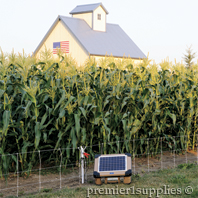
Protecting sweet corn from ravenous raccoons. Make sure to orient the energizer's solar panel to the south in order to take advantage of summer sunlight.
PRS Solar Energizers
Which unit is right for you?
The size, in pulse energy output (range from .5 joule to 2 joules), depends almost entirely on the weed contact that will occur and the length of the fence.
Contact Premier or call 800-282-6631 to speak with one of our fence consultants to help you determine the best energizer for your needs.
You can also view our energizer comparison charts online or in Premier's fencing catalog to help in choosing an energizer.
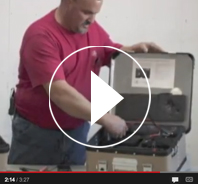
If it's the end of your fencing season, you'll find our video above on how to properly store your energizer and batteries for winter helpful, with instructions and tips the folks at Premier have learned by experience.
HOW-TO VIDEO
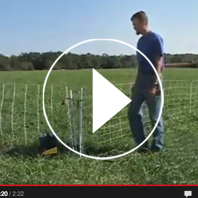 Electric Netting - Ends, Corners and Gates
Electric Netting - Ends, Corners and Gates
| • |
How do I hook 2 rolls of net together electrically?
All nets have a stainless steel clip at the top of each end. Just clip them together.
|
| • |
How do I support it at corners?
Two options:
| • |
Install a strong nonconductive support post.
|
| • |
Drive in a tent peg or steel T post outside
the fence at the corner.
Tie to the netting post
(at least 2" away) with nonconductive string or rope.
|
|
| • |
How do I make a gate?
If possible we use the netting itself as a gate. Turn off the energizer or disconnect PowerLink. Open one end and walk through. PoultryNet HotGate or HotGate Handles are also an option.
|
Important Tip:
The end post of the netting should not touch a building or wood or steel post. Install it at least 2" away.
|
 |
 |
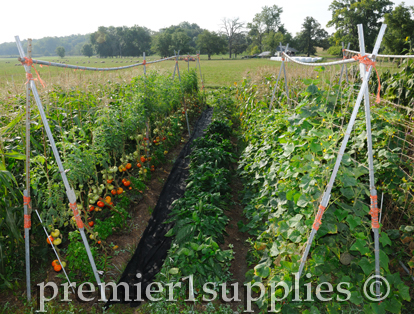
Ripe and juicy! Premier's garden is bursting at the seams with produce. We're enjoying sun ripened tomatoes, cucumbers, corn, green peppers and green beans on a daily basis plus the lettuce patch is still producing!
Update of Premier's Garden
Last month we mentioned the variety and great quantities of vegetables from our garden. We forgot to mention all the eggs that were being produced by the poultry flock on our east farm. Stan's sister, Vivian, tends the flock and delivers eggs here each week.
The combination of eggs and veggies has resulted in several interesting omelet combinations (read about it in our Premier Farm Diary) during lunch hour, including basil and green bean; pepper, eggplant and green bean; and the classic tomato and onion.
The vegetable scraps from the garden are then fed to the chickens. The hens see a piece of something they like, grab it in their beaks and run off (usually accompanied by 2 or 3 other hungry hens). Scraps from the poultry yard are composted with old poultry bedding. This compost will be added to the garden for future veggie production!
Our chickens are eagerly awaiting the chance to get into the garden and enjoy any discarded produce, but they will have to wait until after the harvest before they can roam in the garden remnants. Otherwise, they might be tempted to pick a just-ripened tomato that Adrian was intending to pick.
To follow Premier's gardening throughout the season, see our Newsletter Archives "Garden/Wildlife Newsletters"
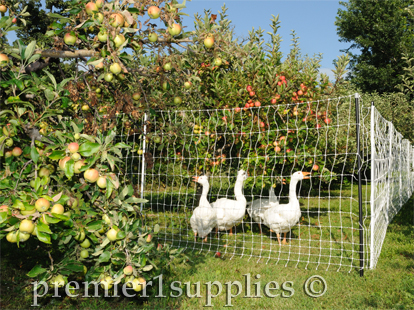
PermaNet® 12/48/3 is for more than chickens and ducks! Geese are excellent animals to use when it comes to weeding. Geese are used at an employee's orchard to keep the weeds down beneath the trees.
|
GARDEN BENEFITS
Composting Chicken Manure
Compiled by Judy Duncan, WSU Cooperative Extension,
King County Master Gardener and Cooperative Extension Livestock Advisor.
Fall, 2005.
Chickens Produce Eggs and Manure
Your chicken produces an egg about every 24 hours, and it is wonderful to have your own home-produced fresh eggs. Your average-size hen also produces 1 cubic foot of manure every six months. What are you doing with this? Manure simply can’t continue to accumulate in your coop. It stinks, attracts rodents and flies, and the ammonia is not healthy for your chickens to breathe.
Benefits of Chicken Manure
Don’t despair; manure can be one of the greatest assets for a home gardener! Although chicken manure is too strong to be used raw on your flowers or vegetables, it can be composted and converted to “black gold”.
If used without composting it could damage roots and possibly kill your plants. However, once it is composted chicken manure is:
| • |
A good soil amendment. Chicken manure adds organic matter and increases the water-holding capacity and beneficial biota in soil.
|
| • |
A good fertilizer. Chicken manure provides Nitrogen, Phosphorus and Potassium to your plants (more than horse, cow or steer manure).
|
Read More »
|
FERTILIZER FOR GARDENS
Using Chicken Manure
Fertilizer In Your Garden
By Heather Rhoades, Gardening Know How
When it comes to manures, there is none more desired for the vegetable garden than chicken manure. Chicken manure for vegetable garden fertilizing is excellent but there are some things you need to know about it in order to use it correctly. Keep reading to learn more about chicken manure compost and how to use it in the garden.
Using chicken manure for vegetable garden fertilizer
Chicken manure fertilizer is very high in nitrogen and also contains a good amount of potassium and phosphorus. The high nitrogen and balanced nutrients is the reason that chicken manure compost is the best kind of manure to use.
Read More »
|
GARDENS & CHICKENS TOGETHER
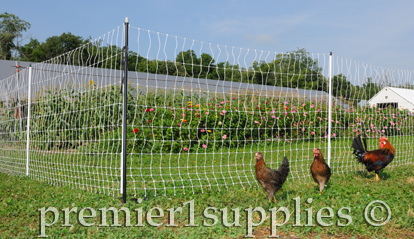
PermaNet® 12/48/3 (which has 3" openings) is useful for keeping chickens either in or out of the garden, depending on the time of year. Other PermaNets have larger openings (6" vs 3" openings) in the lower part of the netting, allowing smaller chickens to slip through.
Netting Options
| • |
PoultryNet™ 12/42/3—This net works well for keeping in most heavy breeds (less so for light breeds). It’s light and easy to handle—and is less expensive than the taller 48" nets.
|
| • |
PoultryNet™ 12/48/3—Better for flightier breeds of poultry. Smaller posts than PermaNet 12/48/3 so it's lighter and easier to move. Designed for frequent moves.
|
| • |
PermaNet® 12/48/3—Designed to stay in one place longer than most other nets. Features the same mesh as PoultryNet attached to thicker posts.
|
Want a net that doesn't sag as much?
We noticed that several netting users have added extra posts to their nets. We understand. We’ve also encountered situations that require less space between the posts.
So we asked our net manufacturer to supply us with nets that have more posts with less space between each post. We call them “Plus” nets.
Their advantages:
| 1. |
Reduced sagging between posts. Sagging can be a problem for nets with many horizontals and verticals (e.g. PoultryNet).
|
| 2. |
Faster and easier to fence curves/corners, and across dips/hills.
|
Their negatives:
| 1. |
The same length of net weighs more.
|
| 2. |
The same length of net costs more—but less than the total cost when users add their “farmstore” nonstandard posts.
|
If you have regular PoultryNet already, try our FiberTuff™ posts to support corners.
|
|